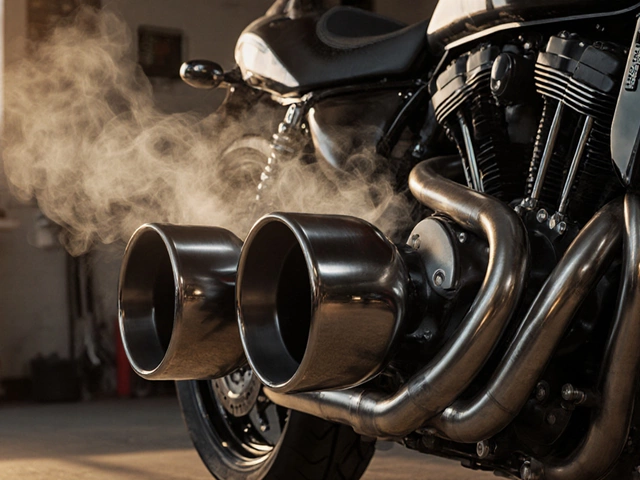
You’re standing in the auto shop holding two bottles of engine oil, both with numbers like 5W-30 and a bunch of logos. Which one goes in your car? Messing this up can mean your engine ages faster, runs hotter, or even starts leaking oil. Nobody’s got time for surprise repair bills—or weird burning smells halfway through a road trip.
Here’s the good news: figuring out what oil your engine needs doesn’t have to be confusing. The trick is knowing where to look and what those numbers and letters are actually telling you. Most of the time, there’s no need to memorize a bunch of technical jargon—your car’s owner’s manual will spell it out for you. But knowing why it matters and what to check is what keeps your engine purring like my cat Whiskers after dinner. And hey, if you want your ride to last, picking the right oil is as basic as getting gas or topping off the washer fluid.
- Why Engine Oil Matters
- How to Read Your Owner’s Manual
- Breaking Down Oil Grades and Viscosity Numbers
- Conventional, Synthetic, and Blends—What’s the Difference?
- Fact vs. Fiction: Common Engine Oil Myths
- Tips for Buying and Changing Your Oil
Why Engine Oil Matters
Think of engine oil as the lifeblood of your car’s engine. Every time you start your car, metal parts start moving fast and rubbing together, and that creates a lot of heat. The oil acts as a thin shield, keeping these parts from grinding against each other and wearing out too soon. No oil—or the wrong kind? Your engine could start to overheat, get noisy, or even lock up tight. Not fun.
Besides just making things slippery, engine oil also helps clean out small junk and sludge that builds up inside the motor. It grabs the dirt, dust, and leftovers from burning fuel and moves it to the oil filter, where it gets trapped. So, fresh oil actually helps keep the engine clean.
Oil isn’t just for cleaning and lubricating—it's also there to cool things down. By moving heat away from the engine’s hottest spots, it prevents sudden breakdowns or even warped engine parts. Modern engines run hotter than ever—some go over 220°F (that’s over 100°C) when you’re stuck in traffic. Running the right oil helps it handle these temps without breaking down or turning into goo.
- Engine oil keeps metal from metal contact, slashing friction and wear.
- It carries away heat to support smoother running.
- It captures dirt and grime, which stops clogs and buildup.
Another thing a lot of people don’t think about: using the wrong oil can mess with your car’s fuel economy. Thick or sticky oil can make the engine work harder, burning more gas. Most new cars are designed for certain oil grades to help squeeze out every mile per gallon.
Just to get a feel for how often we’re all supposed to change oil, check this out:
| Car Type | Recommended Oil Change Interval (Miles) |
|---|---|
| Modern (Synthetic Oil) | 7,500 - 10,000 |
| Older (Conventional Oil) | 3,000 - 5,000 |
In short, picking the right engine oil isn’t just about protecting your engine for today—it’s about saving money on repairs later, getting more out of every tank, and keeping your car running for years. That’s why it’s worth caring about what goes in your engine.
How to Read Your Owner’s Manual
Most people skip the owner’s manual, but when it comes to engine oil, this little book is gold. Don’t go by what the neighbor says or what you heard in an online forum—car makers spend tons of resources to test what works best for your engine. They put all that info in your manual, so you know exactly what keeps your ride running smooth.
First, crack open the manual and look up the maintenance or lubrication section. You’ll find a table or chart listing recommended oil types and the right viscosity grades. This is usually right near other basic stuff like tire pressure and fluid types. If the manual says you need 5W-30, don’t use 10W-40 just because it was on sale.
- Viscosity numbers like 5W-30 or 10W-40 aren’t random. They describe how thick or thin the oil is at different temps—super important for your engine’s health. Stick to what’s listed.
- Check for extra details, like whether your engine needs synthetic oil, a synthetic blend, or just standard oil. Modern engines often need synthetic to handle tighter tolerances and hotter running temps.
- Some manuals give different oil grades for different climates. For example, 0W-20 works better in cold winters, while 10W-40 can handle hot summers. If you drive in crazy heat or cold, follow the manual’s seasonal advice.
- Look for extra requirements like "API Certified" or "ILSAC GF-6." These are quality marks, not just buzzwords. Ignore them, and you could mess with your warranty.
Here’s a look at what you might find in a typical manual:
| Oil Grade | Climate | Type | Certification |
|---|---|---|---|
| 5W-30 | All-season | Full Synthetic | API SP / ILSAC GF-6 |
| 0W-20 | Cold weather | Full Synthetic | API SP |
| 10W-40 | Hot weather | Semi-Synthetic | API SN |
If you’ve lost the paper manual (yup, it happens), try looking it up online using your car’s make, model, and year. Most manufacturers have free digital copies. Never just guess or trust someone’s random suggestion—using the wrong engine oil can cause leaks, noisy engines, and voided warranties.
Breaking Down Oil Grades and Viscosity Numbers
If you’ve ever stared at an oil bottle and wondered what 5W-30 or 10W-40 means, you’re not alone. These numbers look geeky but picking the right engine oil for your car hinges on understanding them. Here’s the deal: those numbers aren’t some secret code, they’re all about oil types and how well the oil flows at different temperatures.
The first number you see, the one before the ‘W’ (which stands for “winter”), shows how thick the oil is at cold starts. The lower this number, the easier your engine will crank during a frosty morning. For example, 0W is thinner than 10W when your car’s been sitting overnight. The second number tells you how thick the oil stays once your engine heats up. So 5W-30 oil gets thick like a 30-weight oil when your engine is hot. Why does this matter? Thin oil at startup protects your engine right away, and thicker oil at high temps prevents metal parts from grinding.
Here’s a simple breakdown of common viscosity grades:
- 0W-20: Great for cold areas and newer engines that need efficiency.
- 5W-30: Probably the most common grade—balanced for average temps and driving conditions.
- 10W-40: Used in older cars or hotter climates where engines run at higher temps.
Think your engine oil is just about hot and cold? Think again. The choice can impact fuel efficiency, how easy it is to start your car in winter, and even whether your warranty stays valid. In fact, a 2023 report from the American Petroleum Institute said that using the wrong viscosity can lower gas mileage by up to 2% and make engines wear out faster.
| Viscosity Grade | Best For | Notes |
|---|---|---|
| 0W-20 | Cold climates, hybrids | Highest fuel efficiency, newer engines |
| 5W-30 | Most modern cars | All-purpose, good for mixed temperatures |
| 10W-40 | Older cars, hot climates | Better protection at high heat |
It sounds simple, but always match your oil grade to what’s listed in your owner’s manual. Car makers don’t just make random guesses—they test engines for years to get that number right. Choosing the wrong viscosity might seem harmless, but it’s kind of like pouring maple syrup in your coffee instead of actual cream—it works, but not for long.

Conventional, Synthetic, and Blends—What’s the Difference?
Let’s clear up the biggest oil aisle mystery: what’s actually inside those bottles labeled conventional, synthetic, and blends? Picking the right engine oil isn’t just about the numbers—what the oil’s made from can make a real difference in how your car performs and how often you’re back in the shop.
Here’s the deal:
- Conventional oil: This is just regular old oil, straight from crude, refined, and stuck in a bottle. It protects your engine and does the job for most standard cars, especially older models. It’s usually cheaper, but it breaks down faster if you drive hard, tow heavy stuff, or deal with extreme hot or cold weather.
- Synthetic oil: This is the high-tech stuff. Lab-designed, super-clean, and full of additives to fight gunk, heat, and wear. Synthetics flow better at cold temps and don’t thin out when your engine’s blazing hot. According to a 2023 Consumer Reports survey, cars using synthetic oil needed almost 50% fewer oil changes per year compared to conventional—meaning less hassle and often better protection.
- Blends (Synthetic Blend): Think of these as the middle ground. They mix conventional with a splash of synthetic. You get some benefits like better high-temp protection and cleaner engines, but the price sits right between regular and full synthetic. Blends are super popular for light trucks and SUVs that haul stuff or see rougher use, but don’t need full synthetic muscle.
| Oil Type | Best For | Main Benefit | Cost (per quart) |
|---|---|---|---|
| Conventional | Older cars, easy driving | Budget-friendly | $4–$6 |
| Synthetic | New engines, extreme weather, turbocharged engines | Top protection, longer intervals | $8–$12 |
| Blend | Trucks, SUVs, mixed use | Balanced performance/price | $6–$9 |
Newer cars usually call for synthetic engine oil, especially if you’ve got turbo or direct-injection under the hood. But if you’re keeping an old hatchback alive or mainly driving short trips, conventional might do the trick and save cash. The real key? Check your owner manual. Using the wrong type isn’t just about spending more—it can void your warranty, hurt performance, or even clog up sensitive parts inside your engine.
Don’t fall for the hype that you always need the most expensive bottle on the shelf. Match what you drive and how you drive, and you’ll get the best out of every oil change.
Fact vs. Fiction: Common Engine Oil Myths
It’s wild how many half-truths and old wives’ tales get tossed around when folks talk about engine oil. Let’s clear up the stuff you’ll hear at the parts counter or from your neighbor who “knows cars.”
Myth 1: You have to change your oil every 3,000 miles.
That might’ve been true twenty years ago, but most modern engines and oil formulas can go 5,000–7,500 miles easily. Some synthetics even stretch to 10,000 miles. Don’t waste cash or oil—check your manual for the real number.
Myth 2: Black oil always means it’s bad.
Truth is, fresh oil turns dark pretty fast as it picks up stuff inside your engine. That’s it doing its cleaning job. If it’s gritty or smells burnt, then you should worry. Otherwise, color alone doesn’t tell you much.
Myth 3: Thicker oil is better for worn engines.
Some think heavy oil, like 20W-50, "cushions" old engines. But too thick can starve parts of lubrication, especially at startup. Stick with what your manual says—most use 5W-30 or 0W-20 for a reason.
Myth 4: Synthetic oil causes leaks in older cars.
This used to be an issue with early synthetics, but not anymore. Today’s synthetic engine oil works fine in older rides, and sometimes even protects better. Leaks usually trace back to worn gaskets, not the oil you use.
Myth 5: You can’t mix different engine oil brands.
Mixing brands in a pinch won’t blow up your engine. As long as the oil types and viscosity are right, your car will be fine. Don’t make a habit of it, but it’s better than running low.
- Bonus Myth: All oil with the same numbers is identical. In reality, two bottles of 5W-30 can have very different additives and cleaning properties. Stick to trusted brands and look for the ratings your car’s maker recommends.
| Myth | What the Data Says |
|---|---|
| Change oil every 3,000 miles | 79% of new cars have recommended intervals above 5,000 miles |
| Black oil is bad oil | Color changes quickly, but lab tests show oil often keeps protecting long after turning dark |
| Synthetic oil causes leaks | Modern synthetic oils are safe for seals in 99% of engines |
Just remember: facts matter more than what you overhear at the garage. Choose the right engine oil for your car, and you’ll avoid the headaches.
Tips for Buying and Changing Your Oil
Walking into an auto parts store can be confusing, but you don’t need an engineering degree to pick the right engine oil. Here’s how to make it simple while saving yourself a headache.
- Check Your Owner’s Manual First: No, seriously, don’t skip this. It lists the exact oil types and grades recommended for your specific model. If it says 5W-30, stick with it unless your mechanic suggests something else for your driving conditions.
- Look for Certification: On the oil bottle, check for marks like "API" or "ILSAC." These show the oil meets big industry standards. Using uncertified oil is like buying a knock-off phone charger—risky and probably not good for your engine.
- Synthetic vs. Conventional: Most new cars are designed for synthetic oil, which lasts longer and protects better at extreme temperatures. If your car’s older and has always run on conventional oil, a synthetic blend might be a happy middle ground.
- Don’t Fall for Price Alone: Super cheap oil may seem tempting, but brands with a solid rep (think Mobil 1, Castrol, Pennzoil) often perform better and protect longer. This is not the place to cut corners if you want to avoid engine problems down the road.
Once you’ve picked your oil, changing it yourself isn’t rocket science. Even if you’re new to it, here’s a quick cheat sheet:
- Warm up the engine for about 5 minutes. Warm oil drains faster, pulling out more grime with it.
- Park on a level surface and set the parking brake. Safety first.
- Place an oil catch pan under the drain plug, unscrew it, and let the old oil drain completely.
- Swap out the old filter for a new one. Always coat the new filter’s rubber gasket in a bit of fresh oil—it’ll help with the seal.
- Screw the drain plug back in, then pour in the new oil using a funnel. Refer to your manual for how much you need—usually 4 to 5 quarts for most cars.
- Run the engine for a couple of minutes, check for leaks, and top up if needed. Don’t forget to reset your oil change light if you have one.
| Oil Type | Mileage Interval |
|---|---|
| Conventional | Every 3,000–5,000 miles |
| Synthetic Blend | Every 5,000–7,500 miles |
| Full Synthetic | Every 7,500–10,000 miles |
One quick tip: Mark the mileage and date of your last oil change somewhere, even if it’s just in your phone. Skipping oil changes is a surefire way to eat through your engine way faster than you’d think. If you drive short trips a lot (lots of stopping and starting), consider changing the engine oil a bit earlier than the maximum recommendation. Your engine will thank you with smoother rides and fewer weird noises.





